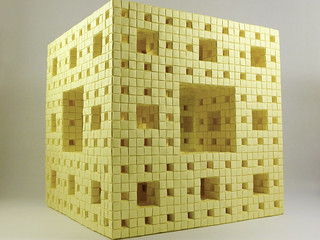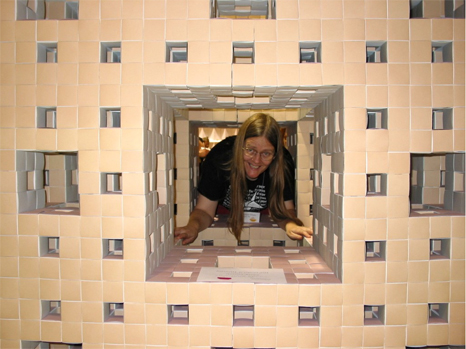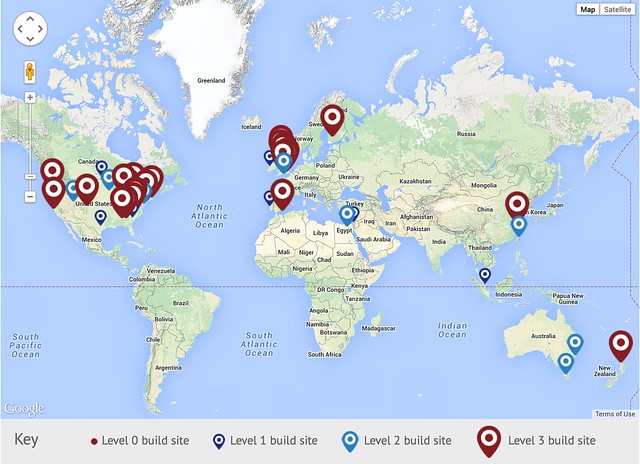Menger Sponges
I know it is hard to grasp, but it is mathematically viable: there are solids that require an infinite amount of material to construct, yet they have no volume! Of course, having infinite surface area makes it impossible to actually build these objects, but it is feasible to come up with reasonable approximations. One approximation to such a construction—the so-called Menger sponge—goes like this:
- Start with a big cube. Visualize this cube as \( 3 \times 3 \times 3 = 27 \) smaller cubes with the same shape and size—like a Rubik’s cube! Remove now the small center cube of each side, and the small cube at the center. We are left with a structure consisting on 20 cubes: those at the corners and the edge cubes connecting them.
- Repeat this process on each of these 20 cubes. We are left with 400 smaller cubes.
- Repeat again (8,000 cubes), and again (160,000 cubes), and again (3,200,000 cubes), …
After three steps of this process we already observe an elegant geometrical wonder.

Level 3 Menger Sponge folded with Post-its
(Copyright) All rights reserved by Nick Rogeux
This object was first described by Karl Menger in the 1920’s, while a student at the University of Vienna. After the end of World War II, Menger accepted a position at the Illinois Institute of Technology, where he contributed to beautiful mathematics in the fields of probabilistic and hyperbolic geometry.
In the early 1990’s, Dr. Jeannine Mosley—an electrical engineer from MIT, with vast experience in computer graphics designing 3D modeling software—had the brilliant idea of creating the level 3 of this sponge by paper folding. The building blocks of this monster being simple cubes, that one could carefully craft from six light-yet-sturdy small pieces of paper. All these pieces needed to have exactly the same shape and size, naturally. For ten years, from 1995 to 2005, she patiently coordinated a very ambitious project where several teams carefully folded, linked, and assembled tens of thousands of business cards into more and more complex shapes. The result was briefly on display in June 2005 at the Origami USA annual convention in Manhattan.

Dr. Mosley, inside of her Business Card Menger Sponge
(Photo by Ravi Apte)
To give you an idea of the magnitude of this enterprise—and at the same time pose a fun puzzle if you are mathematically inclined:
- A level-1 Menger sponge measures \( 6’’ \times 6’’ \times 6’’ \).
- A level-2 Menger sponge measures \( 18’’ \times 18’’ \times 18’’ \). How many cards are necessary for this level?
- The level-3 Menger sponge measures \( 54’’ \times 54’’ \times 54’’ \). If 500 business cards weight 18 ounces, how heavy will this object be at the end?
- This one for the engineers and architects out there: This construction barely supports its own weight. It does so thanks to the sparsity of the cubes. Think of the different horizontal layers, and the different columns. Which layers and columns are more densely packed? What is the weight of the heaviest columns? Can a single cube carry such weight?
- And for an A+: How heavy would a level-4 sponge be? Will it be possible to construct such an animal with business cards?
There are currently 13 more level-3 Menger Sponges in the United States alone. There are other 9 in Europe, one in Asia, and one more in New Zealand. The following (static) Google map shows their locations as of November 6th, 2014.
 </a>
</a>
We, at the Department of Mathematics of the University of South Carolina, are determined to build the next one.
But there is no need to wait 10 years to get this done. Some folks at the Queen Mary University of London figured out a way to reduce the assembly time to just a few days, and posted detailed instructions at megamenger.com.
We will start slow: First, taking advantage of our annual USC High School Math Contest on January 31st, 2015, where we will recruit the help of all high school students, instructors and relatives in attendance. We plan to build that day as many level 2 sponges as we can afford. At a later date, we mean to organize a larger group of volunteers, so we can assemble the final level 3 sponge.
But success of this enterprise starts, obviously, by collecting enough business cards. Just in the first week we gathered enough material for almost one level 2 Menger sponge. Where are we going to obtain all those remaining 48,000+ cards? Do you have any you could spare? We would love to get our hands on them. Bring them to room 413 in LeConte or, even better, drop us a comment below so we can arrange for pick-up.
Progress












Special Thanks
- Cambden Abell
- Jennifer Almeda
- Arnold School of Public Health 3275
- Jessica Atwood
- Nan W. Barker
- Kaitlin C. Blanco-Silva 350
- Judy R. Blyth 220
- Shannon A. Bowen
- Jennifer Breeden 300
- Norvel W. Brown
- Vanessa L. Brown 225
- Larisa D. Bruner
- O. Marion Burton
- Lakesha Campbell
- Toyeka Campbell
- Charlotte Cárdenas 150
- Elliott Davis Decosimo 40,000+
- Emily Carlton
- R. Lawson Cheek, III
- David and Sebrey Clark 225
- Cassey Corcoran
- Eva Czabarka 200
- Darla Moore School of Business 1450
- Edwin M. Dickey 260
- Helen Doerpinghaus
- Andrew R. Dyer
- Monty L. Fetterolf
- Meredith A. Fievet 110
- Dean Mary Anne Fitzpatrick
- Libby Foreman
- Lachelle B. Frederick 150
- Angrew Grubba 200
- Glenda Halter
- Hugh G. Hanlin
- Rachel Hardison 360
- Shae Haskins
- Holly Hayes
- Chris Horn
- John T. Hyatt Jr. 300
- Grant N. Jackson
- Gayle D. Johnson 250
- Carolyn S. Jones
- Kelly Kavanaugh
- Lael M. Kenney 725
- Tracy L. LaPointe 490
- Brian LeDuc
- Chad L. Leverette
- Sarah Livingston
- Lauren E. Lowe
- Juan C. Luvene
- Chris Maw 800
- Sherry Maw 200
- Lisa Martin-Stuart 250
- Matt McGrievy
- Ian McGuire
- Julie Medlin
- John B. Nelson
- Jane K. Olsgaard
- Amanda Polson 275
- Andy Pope
- Christopher Reid 425
- Lauren Reince 200
- Anton Schep
- Lori Schwartz 130
- Michael A. Seaman 500
- Eric L. Sevigny 100
- Cheri Shinn
- Lillian Upton Smith
- South Carolina DAODAS
- Swansea High Freshman Academy
- Mark E. Tompkins 100
- Tufts Print & Copy Center 1000
- UofSC Aiken 675
- UofSC College of Arts and Science 500
- UofSC College of Education
- UofSC ISS 985
- UofSC Office of the Provost
- UofSC School of Medicine 275</li>
- UofSC Study Abroad Office
- UofSC University Writers Group
</ul> </div> </div>